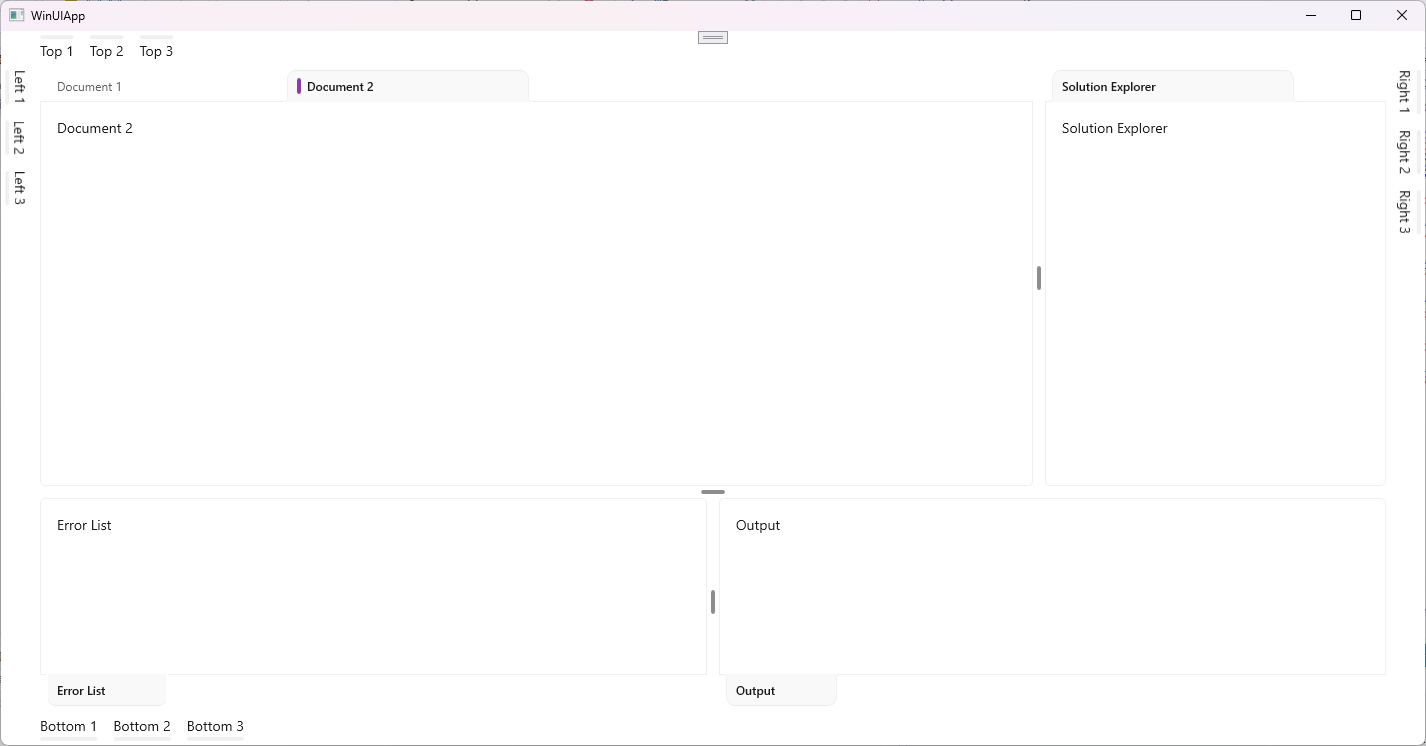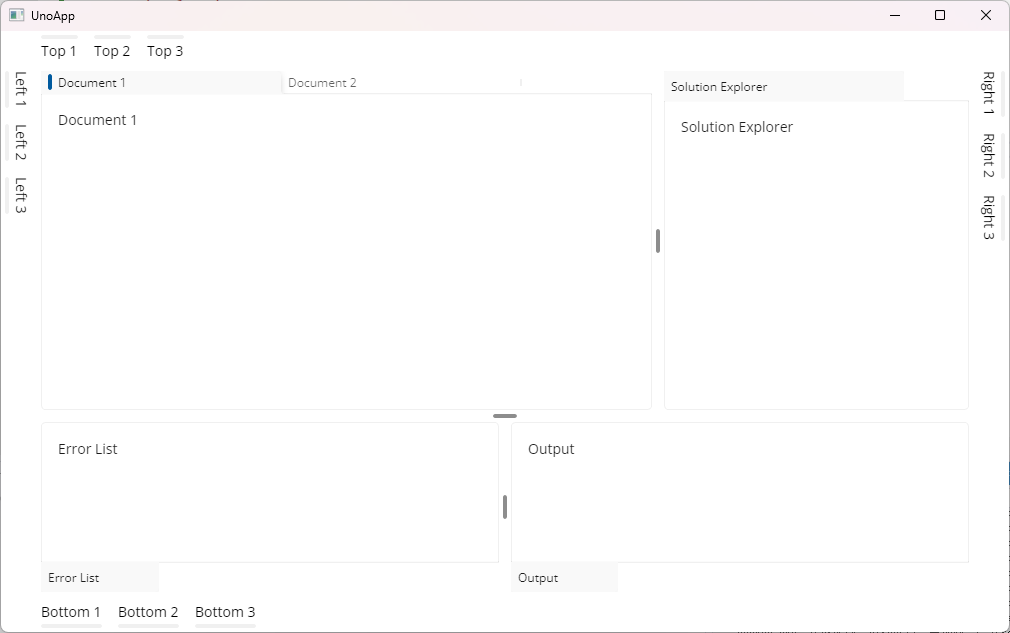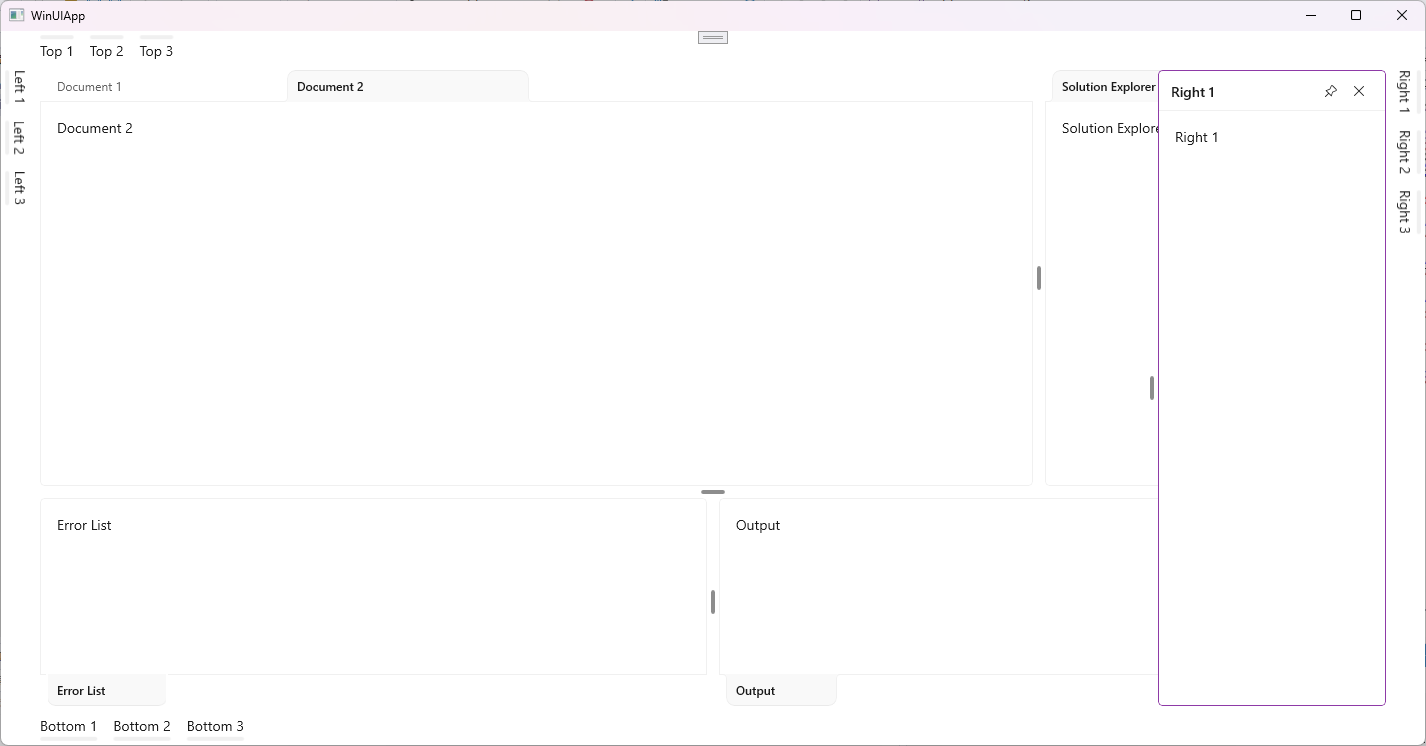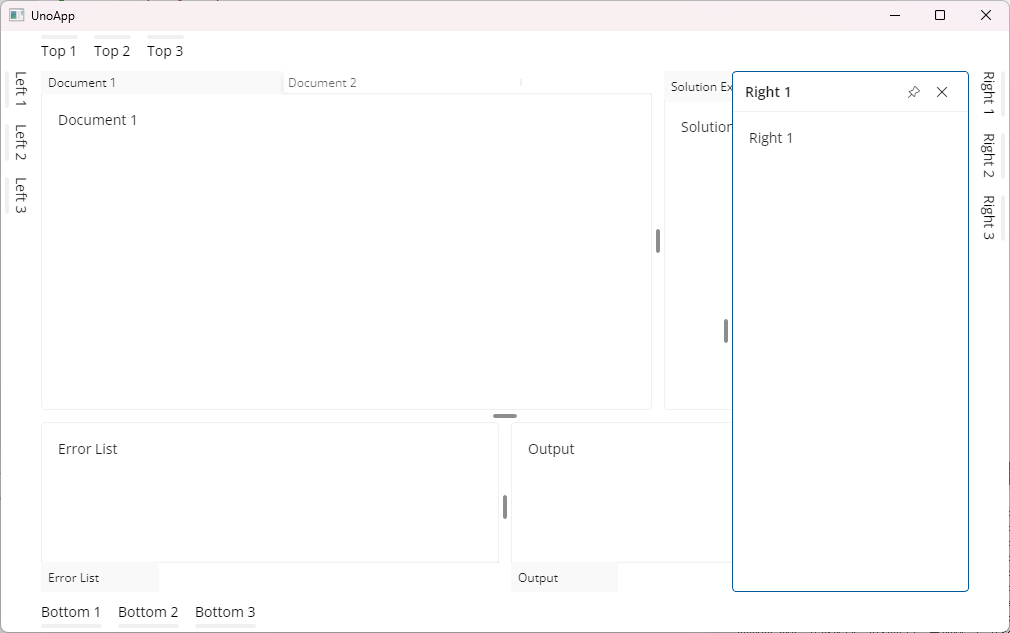WinUI.Dock is a docking control similar to Visual Studio, based on WinUI 3. Its design is inspired by AvalonDock and ImGui.
- WinUI 3.0
- Uno Platform (partially available)
-
DockManager: DockManager is the manager of the entire layout, responsible for managing all intermediate layouts, windows, and sidebars.
- Panel: Intermediate layout, its type is LayoutPanel.
- ActiveDocument: The currently active Document.
- ParentWindow: Parent window, used to activate when dragging a Document to the current window.
- LeftSide, TopSide, RightSide, BottomSide: Sidebars, their child items are of type Document.
- CreateNewDocument: Event triggered when restoring the layout.
- CreateNewGroup: Event triggered when dragging a Document to a specified target.
- CreateNewWindow: Event triggered when dragging a Document outside the window.
- ActiveDocumentChanged: Event triggered when the active Document changes.
- ClearLayout, SaveLayout, LoadLayout: Clear layout, save layout, load layout.
-
Document: Document.
- Title: Document title.
- Content: Document content.
- CanPin: Whether it can be pinned.
- CanClose: Whether it can be closed.
-
DocumentGroup: Document group.
- Children: Document group child items, their type is Document.
- TabPosition: Tab position.
- IsTabWidthBasedOnContent: Whether the tab width is based on content.
- SelectedIndex: Selected index.
-
LayoutPanel: Layout panel.
- Children: Layout panel child items, their type is LayoutPanel or DocumentGroup.
- Orientation: Layout orientation.
-
Document, DocumentGroup, LayoutPanel: Common properties.
- Owner: Owner, representing the parent.
- Root: Root node, representing the top-level DockManager.
- DockMinWidth, DockMinHeight: Minimum width, minimum height.
- DockMaxWidth, DockMaxHeight: Maximum width, maximum height.
- DockWidth, DockHeight: Width, height. (When in the intermediate layout, it will be allocated as a proportion, similar to Grid's RowDefinition and ColumnDefinition)
- Install the NuGet package
Install-Package WinUI.Dock
- Add the WinUIDockResources in App.xaml
<Application.Resources>
<ResourceDictionary>
<ResourceDictionary.MergedDictionaries>
<XamlControlsResources xmlns="using:Microsoft.UI.Xaml.Controls" />
<dock:WinUIDockResources xmlns:dock="using:WinUI.Dock" />
</ResourceDictionary.MergedDictionaries>
</ResourceDictionary>
</Application.Resources>- Add the DockManager control in MainWindow.xaml
<Window xmlns:dock="using:WinUI.Dock"
x:Name="Main">
<dock:DockManager CreateNewDocument="OnCreateNewDocument"
CreateNewGroup="OnCreateNewGroup"
CreateNewWindow="OnCreateNewWindow"
ParentWindow="{Binding ElementName=Main}">
<dock:LayoutPanel Orientation="Vertical">
<dock:LayoutPanel DockHeight="2" Orientation="Horizontal">
<dock:DocumentGroup DockWidth="2">
<dock:Document Title="Document" CanClose="False" CanPin="False" />
</dock:DocumentGroup>
<dock:DocumentGroup DockWidth="1">
<dock:Document Title="Solution Explorer" />
</dock:DocumentGroup>
</dock:LayoutPanel>
<dock:LayoutPanel DockHeight="1" Orientation="Horizontal">
<dock:DocumentGroup IsTabWidthBasedOnContent="True" TabPosition="Bottom">
<dock:Document Title="Side##Error List" />
</dock:DocumentGroup>
<dock:DocumentGroup IsTabWidthBasedOnContent="True" TabPosition="Bottom">
<dock:Document Title="Side##Output" />
</dock:DocumentGroup>
</dock:LayoutPanel>
</dock:LayoutPanel>
</dock:DockManager>
</Window>- Add the following code in MainWindow.xaml.cs
// This event is triggered when restoring the layout, you can add content to the Document in this event.
private void OnCreateNewDocument(object _, CreateNewDocumentEventArgs e)
{
e.Document.Content = new TextBlock()
{
HorizontalAlignment = HorizontalAlignment.Center,
VerticalAlignment = VerticalAlignment.Center,
Text = $"New Document {e.Title}"
};
}
// A special character "##" is added in the Title, and only the content after "##" will be displayed in the final interface.
// When dragging a Document to a specified target, a new DocumentGroup will be created, and this event will be triggered, allowing you to customize the properties of the DocumentGroup.
private void OnCreateNewGroup(object _, CreateNewGroupEventArgs e)
{
if (e.Title.Contains("Side"))
{
e.Group.TabPosition = TabPosition.Bottom;
e.Group.IsTabWidthBasedOnContent = true;
}
}
// When dragging a Document out, a new window will be created, and this event will be triggered, allowing you to customize the title bar of the window.
private void OnCreateNewWindow(object _, CreateNewWindowEventArgs e)
{
e.TitleBar.Child = new TextBlock()
{
HorizontalAlignment = HorizontalAlignment.Center,
VerticalAlignment = VerticalAlignment.Center,
Text = "Custom Title"
};
}- Run the program to see the effect.
- The project is currently in an early stage and may have many issues. Please do not use it in production environments.
- The Uno Platform has only been tested on the Skia platform and does not support cross-window dragging. It works properly if used within a single window.
| WinUI | Uno |
|---|---|
 |
 |
 |
 |
